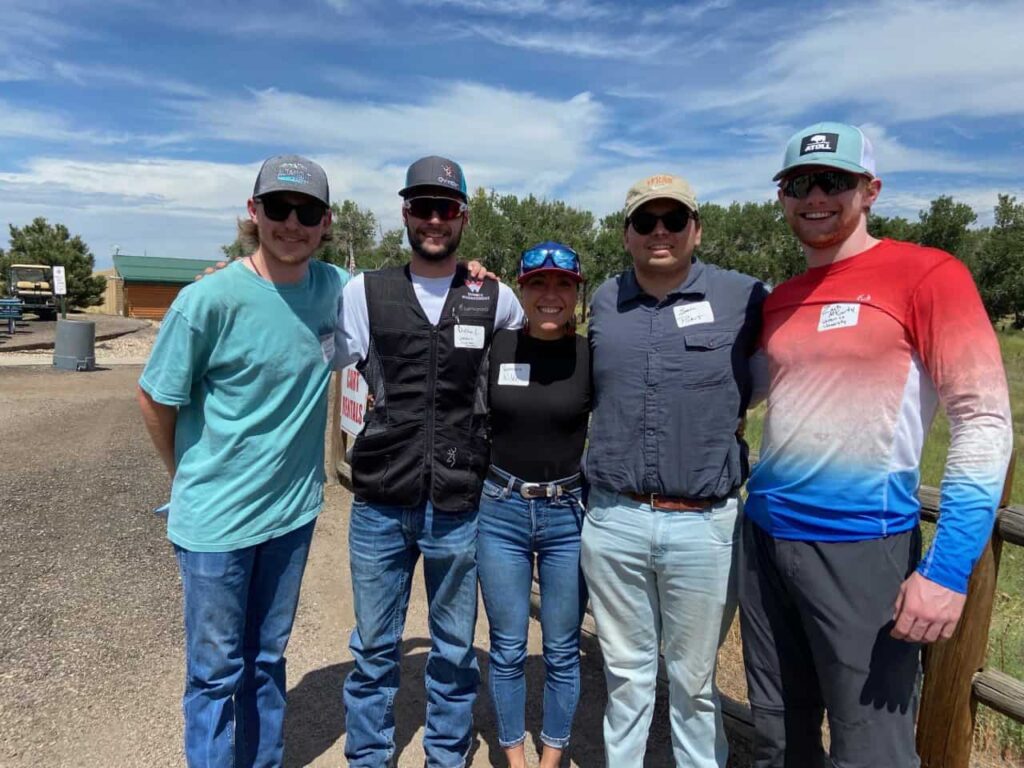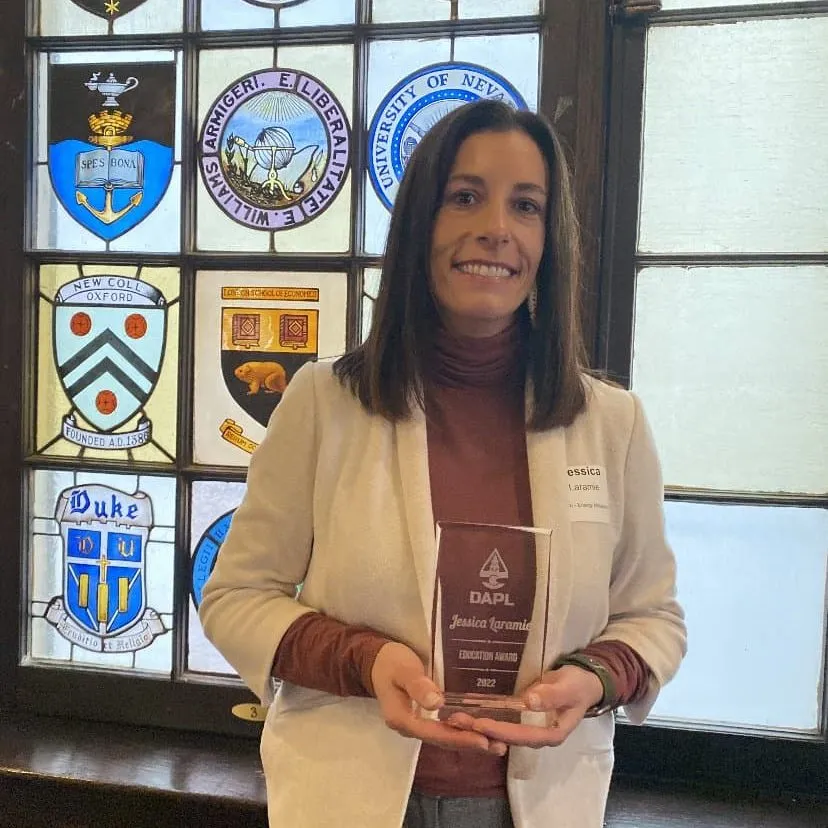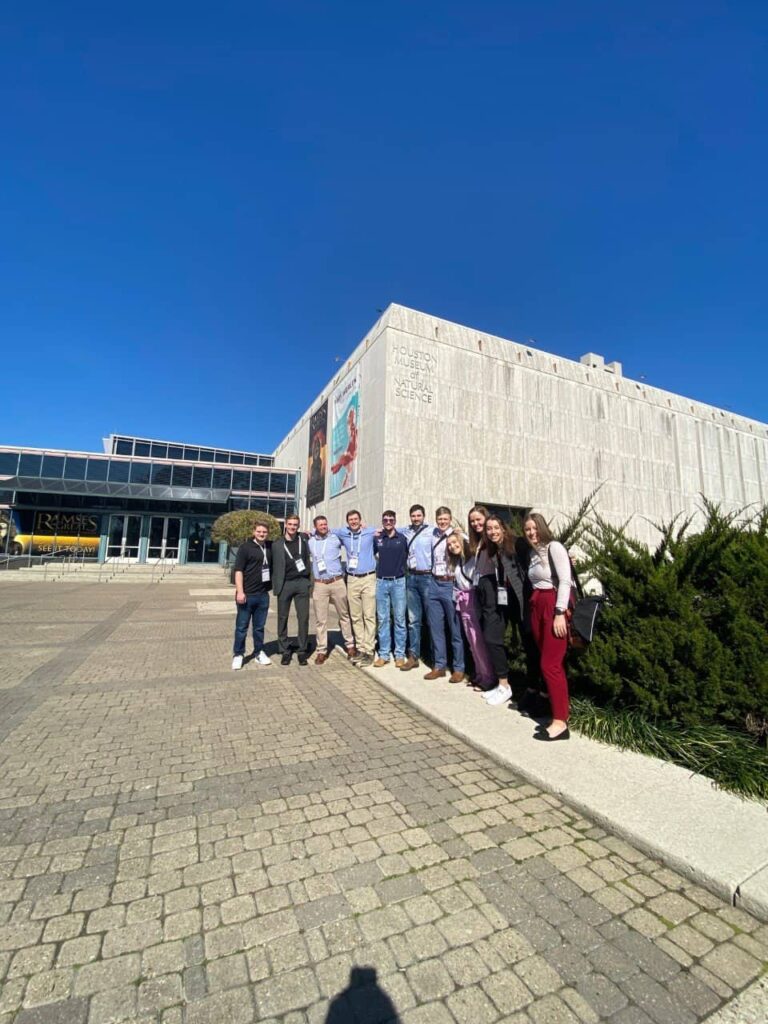Prof. Jessica Laramie, external communications manager Veronica Wilde, and senior student Dalton Lorenz discuss revamping the Energy Management program, a recent curriculum overhaul, and the program’s public perception
By Kira Cordova

“Take care of people, learn the legal side of it, and try and make the world a better place.”
That’s how Veronica Wilde, who manages external communications for the Energy Management (EM) program at Western, describes the budding EM program, originally founded in 2008.
Wilde, who splits her time between recruiting and fundraising, and program director Jessica Laramie, who designed the program’s new curriculum that was implemented this year, are striving to make the EM program truly intersectional by cutting across a wide swath of topics.
In their eyes, a broad, diverse curriculum will equip graduates to create real world solutions to complicated issues in the energy industry while maintaining the program’s vaunted 100 percent graduate placement rate.

A broad foundation of knowledge
The Energy Management (EM) degree at Western is an emphasis within the Business Administration major — a 74-credit program which includes courses in wide-ranging disciplines, including accounting, geology and environment and sustainability. The program also houses a 19-credit minor option.
The emphasis aims to be far-reaching, and its website boasts testimony from students with goals that range from “[wanting] to help businesses become more energy efficient as a sustainability consultant” to “[representing] oil and gas companies as a landman.”
Largely because of that diversity of intended outcomes — and the built-in complexities of the energy industry — the EM program has students delve into topics ranging from renewable energy, oil and gas, and minerals to the nuances of federal, state, private, and Native American real estate and land management.
In the program, finding a student’s particular niche starts with presenting a practical, well-rounded curriculum and ends with helping graduates start solid careers that they are passionate about.
“Part of the energy management sell to is really the practical skill sets with the experiential learning and ownership of your own future, really carving a path for yourself within an area that you’re interested in,” Laramie says.
“We maintain a 100% placement rate for interns and graduating seniors for 8 years running,” Wilde adds.
Both Laramie and Wilde, the only full-time staff dedicated to the EM program, strive to place students at companies that Western’s program has established connections with — and ones where they know their students will be a natural fit.
Laramie first came to Western in 2015 after teaching in the law program at Denver University (DU) and working for the oil and gas startup Jonah Energy in Denver, which acquires and develops oil and gas properties.
Laramie was honored this past December for her outstanding work as a Colorado educator in the energy industry when she received the 2022 Denver Association of Professional Landmen (DAPL) Education Award.
She believes that nesting EM within the Business Administration major, while it creates an intense credit load, also serves to build a solid foundation for students seeking work in the energy industry — rendering graduates more flexible and resilient for their future careers.

Responding to a changing world
The EM program at Western was first born in 2008 as the first privately funded Energy Management degree program in the United States. A mix of Western alumni — along with individuals and companies within the energy industry —including the Moncrief family of Gunnison, pooled over $3 million to begin the program. Classes kicked off in the spring semester of 2008.
“At that time it was called the Professional Land and Resource Management (PLRM) degree,” Laramie notes.
In 2015, when Laramie first started as a faculty member, the program underwent a name change to officially become the Energy Management program. That name change marked the start of a broader program renaissance that Laramie has largely overseen.
“We’ve always been heavily rooted and focused on oil and gas development,” she says. “About a year and a half ago, we decided to really focus on broadening opportunities for students in all forms of energy development, and so now we have some students that are working in solar, and we have some partners that are doing utility and community-scale solar, battery storage, and carbon sequestration.”
Laramie and Wilde, together with the program’s industry partners and the Western Energy Management Student Association (WEMSA), are always working to maximize the program’s skill development offerings and embedded experiences.
“Recently, we’ve had students go into some other types of positions like sustainability or ESG reporting, and that’s really been a part of a larger push [within] our program to broaden beyond some of our traditional placements or partnerships that we work with externally,” Laramie adds.
Senior Dalton Lorenz, a native of southeast Kansas and president of WEMSA who has secured a post-graduation placement at Ovintiv Energy, has recently been meeting with the Bureau of Land Management (BLM) in Gunnison to set up internship opportunities for students outside the realm of oil and gas.
Laramie says that the core skills for traditional land work and for these newer, more environmentally-focused placements “have proven to be very similar.”
The role of industry partners
This broadening of scope mirrors changes within the larger energy industry, which the EM program maintains close ties with through the various energy industry companies and trade organizations that constitute its industry partners.
Those partners contribute to funding the EM program’s operations and participate in its external advisory board — helping the program stay up-to-date with industry developments.
“We’re really uniquely positioned in that we’re partially funded by the school, and we’re partially funded privately,” Laramie explains.
“Part of that external piece, that private piece, [means] that we also have a lot of external-facing capability outside of Western, so our program is positioned to really be able to keep an eye on what’s going on in the energy industry,” she elaborates.
One such partner organization is PDC Energy, an independent oil and gas company that operates, among other places, in the Wattenberg Field in Colorado.
Wilde describes the company as one of the most active community supporters of the program on the Front Range, and PDC Energy frequently funds EM events and student scholarships, including a Women in Energy scholarship designed to increase female enrollment in EM at Western.
The company also funds the program’s March high school recruiting weekend, where Western hosts high schoolers interested in studying energy management so that they can get to know the program on a personal level, experience Gunnison, and work one-on-one with professional mentors from both PDC and Western.
During the most recent March event, the EM program awarded $60,000 of scholarships made possible by PDC. These scholarships benefit more than 30 of the students currently enrolled in the program.
Shifting to ESG
Recently, when PDC Energy and other industry partners started outlining and implementing ESG goals (a framework used to promote environmental, social, and governance sustainability), it signaled a broader change in the energy industry that the EM program at Western has been tracking and mirroring.
“It’s been exciting to be going through that broadening [process] because it is a more resource neutral shift that has a lot of benefits in a lot of different ways,” Laramie says of the corresponding curriculum update.
“The energy industry itself is broadening, but to appropriately and effectively address poverty, energy poverty, disparity, security, health, safety, and the environment — all energy matters — and all energy is good energy,” she expands.
Laramie notes that the new curriculum focuses on analyzing the full lifecycle of developing energy resources, from the supply chain through to manufacturing and into proper disposal and end-of-life. She notes that it’s important to understand the social, economic, and environmental impacts throughout the entire resource lifecycle.
“One of the coolest things I’ve seen over the past couple of years is that students really want to find a meaningful career and they also want to make a difference and be a part of change — they want practical solutions to real problems,” she says.
That said, Laramie isn’t ready to pronounce a full break from oil and gas, despite direct calls to do so from various environmental and scientific organizations, including the Intergovernmental Panel on Climate Change (IPCC), a body of the United Nations composed of the world’s top climate scientists.
“It’s important to acknowledge and accept and address that we have a tie — and have historically had a tie — to hydrocarbon development, and hydrocarbons are a part of that picture of the future for the energy industry and for energy production going forward,” Laramie offers.
Broadening the program’s horizons
Western’s EM program is uniquely situated in that it is just one of just 11 collegiate programs accredited by the American Association of Professional Landmen (AAPL) nationwide.
The program continues to prepare students to work in more traditional oil and gas roles while broadening both the skills it imparts, and the destinations where its students are placed after graduation.
At the same time, the energy management field is wrestling with larger issues of equity, fairness, and access that have taken center stage within academia, and among society at-large.
“The major issues around energy today [are] access, affordability, reliability, and really making sure that the solutions we bring to the table are considering the populations that have traditionally been underserved in thoughtful and productive and helpful ways that really lead to progress,” Laramie notes.
In creating those solutions, she says that she would love to see collaboration across campus, immersing EM students in a wide range of experiences, coursework, and thought at Western to foster their growth as learners and as soon-to-be professionals.
Wilde adds that she and Laramie have been meeting with Dr. Kate Clark and Professor Karen Hausdoerffer in the Environment and Sustainability (ENVS) department about a prospective collaborative energy center on campus where EM and ENVS students could cooperate on class projects.
While Wilde notes that neither department has the capacity to “fully bring this concept to pitch” right now, she says they’re still working together to help students who are interested in energy find a course of study at Western that suits their interests.

Growing the program
Wilde says that when Laramie first took the reins as director back in 2020 the program enrollment had fallen to just nine students. That drop in enrollment directly followed global market trends; Wilde remembers — you could overlay a graph showcasing the drop in enrollment with one depicting the drop in oil prices, and they almost perfectly aligned.
Laramie quickly realized that if they didn’t boost their student numbers, it was likely they would have to shutter the program for good.
Since that inflection point, enrollment has quadrupled — a fact which Wilde directly credits to Laramie’s leadership — including the curriculum revamp and the time she invests working directly with the students in the program.
“The one-on-one time Jessica is spending with our students is incredible,” Wilde says. As a fresh example, she cites the way Laramie kickstarted the academic year by hosting an “energy management bootcamp” workshop series where she detailed the program offerings and expectations, then laid out an events calendar for the upcoming year.
On her end, Laramie says her favorite part of the EM program is the small, intimate size, which enables her to have meaningful one-on-one interactions with students. She relishes connecting students with the external mentors, job opportunities, and companies that will shape their future.
To further boost student engagement, Wilde and Laramie launched a student enrichment committee this fall comprised of Wilde, a number of industry representatives, and participating advisory board members that Wilde says has already completed over 25 mock interviews and more than 40 resume reviews in the last several months.
On a practical level, Laramie prizes the program’s adjunct faculty who work in the energy industry outside of academia, believing they serve a critical role in modeling what potential career paths will look like in practice.
The student vantage
As the current president of WEMSA, EM’s partnered student organization, Lorenz describes the club as a vessel to communicate with the program’s leadership, including the advisory board.
Additionally, WEMSA aids students by hosting networking events that help them tap into the extensive opportunities that the program provides.
“Whether it be wind or solar or oil and gas, whatever your interest may be, they’ve given us the opportunity to meet lots of talented individuals [in those fields],” Lorenz says.
Beyond the professional utility, he notes that WEMSA is also simply “A way for us to get to know each other in the program on more of a personal level.”
Although Western’s EM program is one of only 11 AAPL accredited programs nationwide, Lorenz says he often gets asked: “Western? Where is that at?”
Going into the energy industry, one of his immediate goals is to help put Western on the map, expanding the possibilities for future alumni.
Overcoming the headwind
Being a newer program in a smaller, more niche field, neither Wilde nor Lorenz were aware of the EM program when they started their academic careers as Western students.
Lorenz began at Western as a general business major, but he stumbled upon the EM emphasis after interviewing Laramie as part of his Headwaters course.
Wilde graduated with a degree in business with dual minors in pre-law and sociology and went on to earn a Outdoor Industry Master’s of Business Administration (OIMBA) as a Mountaineer.
She originally hails from Alaska and was previously a sponsored rock climber. That outdoorsy background imbued her with a deep appreciation for nature and the environment.
Wilde accepted the external communications position for the Energy Management program after working for both the business and OIMBA programs. She admits that she was initially reluctant about taking the role because she associated the program with fossil fuels.
“[Energy is] a pretty intense subject that can have heavy bias,” says Wilde, who believes that bias and the associated controversy contributes to a “headwind” that can work against the program’s success.
“It is reflective of a national and global divide,” she says. “The number one thing that surprised me about working in Energy Management is if you give it time, it is always easy to find middle ground.”
In Wilde’s view, the role of faculty is to provide facts around energy and let students come to their own conclusions.
“I was somebody who had those same thoughts and mentalities about how our program operated as a student, and now one of my huge recruitment lines is, ‘If I would have known what this program actually was, it’s likely the program I would have gotten a degree in [because] law, business, and sociology are at the root of our program.’”
“That headwind is not as strong as we think it is as long as we learn how to talk to one another,” she concludes.

